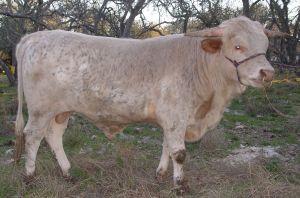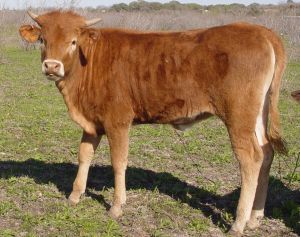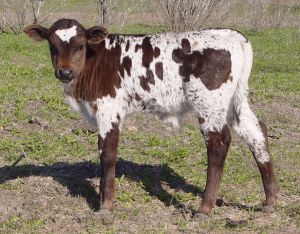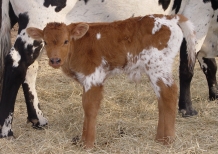|
Home
Longhorn Herd Sires
Foundation Longhorns
Texas Longhorn Cows
Texas Longhorn Heifers
Texas Longhorn Calves
Texas Longhorn Semen
Texas Longhorn Embryos
Longhorn Riding Steers
Texas Longhorn Links
Texas Longhorns Sold
Longhorn Cattle History
Cross Breed Longhorns?
Invest in Longhorns
Test Tube Farm Stock
Longhorn Brisket Recipe
Longhorn Burger Recipe
|
|
Farm Stock From Test Tubes
By G. W. Salisbury (November
1946)

A cow in heat has the very
Old Nick in her. She bawls, throws her weight about and jumps
fences. Until a few years ago the sight of a couple of men trying
to drive a cow down a
country road to the nearest bull was a common sight. There she was
serviced for the
traditional fee of one dollar and the owner prayed that he wouldn't have
to repeat the
performance in three weeks. The proximity of the bull, rather than
his breeding, was
paramount.
The result was a steadily deteriorating brand of
livestock.
In course of time, this periodic chore of the small
farmer will become increasingly rare. He
now has recourse to a modern and thoroughly scientific service that he
can bring to his farm
by a telephone call.
This is artificial insemination.
Probably no recent development in the entire
agricultural field has created more interest
than has artificial insemination. Expanding from a modest
beginning in New Jersey and
New York in 1938, the cooperative program of breeding dairy cows by
artificial insemination
has increased to the point where farmer-owned organizations are breeding
probably as many
as a quarter of a million cows by this means this year.
During one recent month, nearly 500 cows were
artificially bred to one bull in the state of
New York. Under natural service this same bull would undoubtedly
have bred less than 100
cows in an active year. On the average dairy farm in that state he
would probably have been
bred to fewer than 25 cows a year. Already there are bulls in
active artificial service that have
sired 1,500 calves.
If the technical developments continue in this field at
a rate comparable to that of the past
six years, it is not too much to expect that, in the future, some bulls
may be bred to several
thousand cows each year. This technique of dairy cattle breeding
has an enormous potential
for good. A bull requires 27 bushels of corn 500 pounds of
supplement and two tons of hay
per year to keep him in good condition. The cost of this feed will
cover the insemination fees
for a large herd of cows. If a bull is kept to service a small
herd, the farmer is out of pocket.
In its simplest terms, the technique of artificial
insemination of dairy cows is not a
particularly difficult process. In its particulars--in those
things which make it successful and
useful--it is a complicated and technical business.
Briefly, the semen, containing the male sperm cells or
spermatozoa, is collected from the bull at periodic intervals by means
of a semen collector. The process is entirely natural, and in the
hands of a good operator, is not harmful to the bull.
The semen is examined by trained technicians, diluted
with suitable diluting fluids, and prepared for transportation to the
farm or for shipment to some distant point.
Cows in estrus, or heat, are inseminated with the
diluted semen by means of a small-bore glass or compostion tube directly
into the reproductive tract. The diluted semen is usually
introduced into the uterus or the passage opening in this organ.
The tube is guided into the passage by a variety of means. In the
hands of a good inseminator remarkably successful results have been
obtained.
When the experimenters have discovered a way to keep
semen indefinitely, when it can be stored in the family icebox and used
when needed, then the privately owned bull will pass out of the picture.
A few lessons from an expert inseminator should be sufficient to teach
the cow owner how to do the job of insemination.
The results of artificial breeding solely from the
standpoint of its effectiveness in getting cows safely with calf are
variable. There are so many factors which may influence the
results that the wonder is that cows ever conceive by artificial
breeding. However, good technicians using the semen of highly
fertile bulls in herds where disease was not a controlling factor have
obtained results entirely similar to the results obtained under these
circumstances with natural service.
Provided the variable human equation is eliminated,
results are about what they would be in natural service. Records
on some herds show most cows conceiving on first service, in others many
breedings are necessary, and sometimes conception never results.
Records kept since 1938 in New York show that the
results have gradually improved with the years, as the inseminators, the
dairymen, and others concerned have gained in experience. During
the past two or three years, between 50 to 60 percent of the cows bred
have conceived on first service. These data include literally
hundreds of herds and many inseminators.
The cow owner must be alert to catch the cow as she is
coming into heat, and to report it promptly. The period during
which the cow will conceive varies as does the length of the period.
The signs are unmistakable. The cow bawls, becomes excited and
jittery, eats little, and urinates a great deal. She rushes about
as if she is looking for something, as she indeed is.
Looking at the results from the standpoint of the kind
of calves produced it can be said that they are just what would be
expected from such parents. The calves are neither better nor
worse than would have been expected from the same parents through
natural service. If the bull is fertile there will just be more of
them!
As far as the writer is aware, no calves from
artificial service have ever been born with glass legs, nor have they,
as cows, produced milk already bottled because their mothers were scared
by a test-tube.
It is apparent that for wide use, such as is the case
with artificial breeding, that while purebred sires should be used, they
must be carefully selected to do their job. Mistakes in the
selection of bulls will prove costly. Bulls which decrease the
average production of a herd are the expensive bulls because they reduce
farm income.
It is imperative that the records of production used as
a basis for selecting breeding bulls be made under conditions similar to
the conditions on the farms where the bulls are to be used. Forced
records of production give information on the transmitting ability of
dairy animals which must be greatly deflated before it can be applied to
conditions on average dairy farms.
Dairy farmers must pay more attention to the proving of
their own bulls. Constructive programs for aiding the dairymen in
this difficult venture will have to be established in the areas where
artificial insemination is to be used.
Today, far to little effort is expended in this
direction and many of the bulls now in use in artificial insemination
are not good enough. Herein rests a great opportunity for the well
established large breeding establishment that produces good breeding
males.
However, the fact that the bulls will be bred to so
many more cows than would normally be the case will prove without much
doubt just what that bull is capable of doing. Such careful
scrutinizing of breeding bulls will tend to weed out many counterfeits.
The weeding process should be done before a poor bull has done
irreparable damage.
The results of artificial breeding in cooperative,
farmer-owned organizations from the standpoint of financial success or
failure has been just as variable as the human beings directing it.
Some Cooperatives have flopped dismally due to business mismanagement,
to the use of unsatisfactory bulls, to the inability of the inseminator
to get the cows in calf because the semen had deteriorated, the cow was
not in heat, or the clumsiness of the inseminator.
The cost of membership varies from $5 to $25 with
refunds if the association prospers. Fees for service range from
$5 up with smaller amounts for second and third service for the same
cow.
Other organizations have weathered the trials of early
growth in a satisfactory manner and are operating within their income.
There was a tendency on the part of too many such organizations to start
operations with insufficient working capital and too few cows signed to
be artificially bred.
Artificial insemination has been successfully tried in
other classes of stock, as well as dairy cattle. In specialized
cases artificial breeding has been used in the breeding of beef cattle
even under range conditions. It is possible that it may have more
application than it has been given.
The question is often asked as to what groups or
interests were opposed to artificial insemination with dairy cattle.
No organized or widespread opposition to the practice has ever existed
in this country. Certainly some breeders, some dealers, some
veterinarians, some breed association men, some agricultural
journalists, some professors in the colleges and some others did express
opposition to it. No group or interest however was unanimous in
its opinion, nor was any campaign waged against it. Rather, the
converse was true. Probably no technique in dairy cattle breeding
was more universally backed than was artificial insemination, but the
claims for it have far out-reached what it was able to do. After
all, its just another way of mating two animals, and while more cows can
be bred with a single service than is possible with natural service, it
has no other important virtues.
Because artificial insemination has within it
potentialities for good by multiplying the value of a sire able to
transmit proper type and high yields of milk and fat, it also has
potentialities for harm. Picture, if you will, the harm that could
result from the widespread artificial use of a sire that transmitted
some dread disease. Or, imagine the result if a bull were used to
breed thousands of cows that decreased fat production of his daughters
fifty or more pounds below the level of their dams.
Artificial insemination on a broad scale carries with
it not only opportunity, but responsibility.

Here are a few examples of what we have produced utilizing Artificial
Insemination in the Texas Longhorn
cattle industry.
|

Sired by Awesome Viagra |

Sired by Shadowizm
|

Sired by PCC Evader |

Sired by Hondo

|



![]()